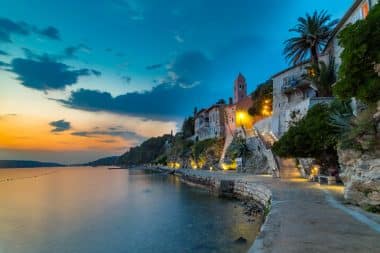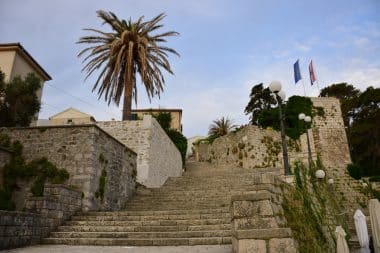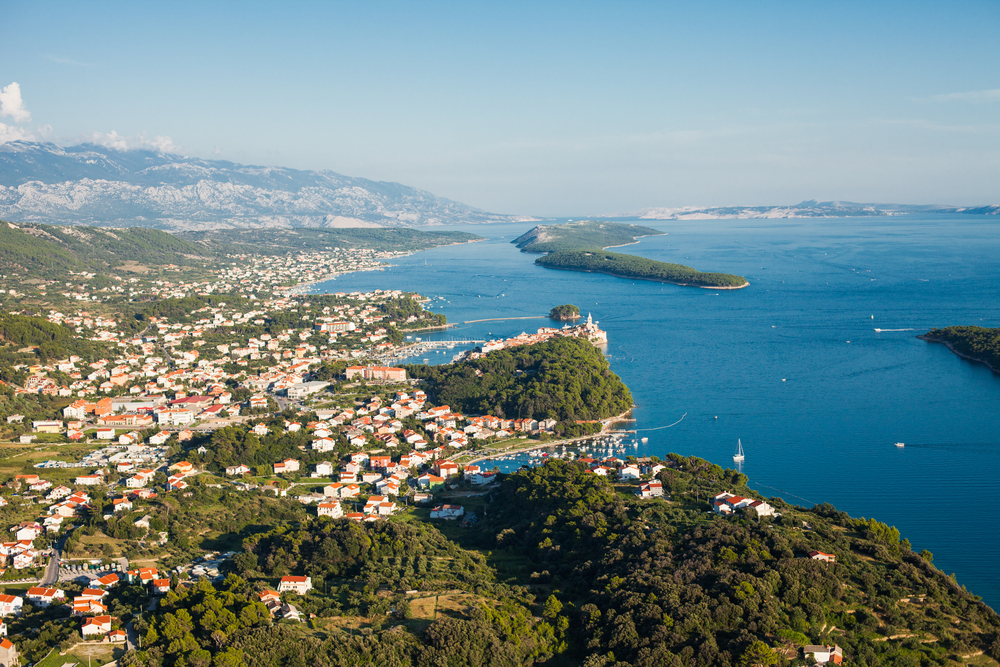Rab is an island in Croatia’s Kvarner Bay in the northern Adriatic Sea. It is wedged in by the neighboring islands of Krk, Cres/Lošinj and Pag. In the immediate vicinity is also the uninhabited island of Dolin. The Velebit Channel separates Rab from the mainland. The main island town is the town of Rab on the west coast. The northernmost village is called Lopar. Rab measures about 22 kilometers in length and 11 kilometers in width. Almost half of the island is forested. Three ridges stretch over Rab; the largest is Kamenjak. To the west is the Potash Front, one of the last oak forests in the Mediterranean. Rab has over 300 springs, many of which are of drinking water quality. Because of its green landscape, Rab is also known as the “emerald island”.
Several dominions and a patron saint
As early as 350 BC. the island was settled by the Illyrians. In the 1st century AD it was a Roman municipality, and from the 9th century until 1409 it belonged to Croatia. It was then assigned to the Venetians until 1797. For a short time, the Austrians came into play. In 1805, Rab belonged to the Illyrian provinces of Napoleon. In 1814, the island was again Austrian for four years, only to be occupied by Italy . In 1920, Rab finally fell back to the motherland, and 21 years later it was occupied by Italian troops. In 1945, the island reverted to Croatia and thus belonged to Yugoslavia. After its decline, Rab became part of the independent state of Croatia. While several rulers took over Rab, the island had only one patron saint: St. Christopher. His skull is kept as a holy relic on the island.
Arrival only possible by sea

Climate, Flora & Fauna
Rab has mild winters and moderately warm summers, which makes the island an ideal holiday destination all year round. The thermometer hardly ever drops below zero degrees. The average water temperature in the summer months is a pleasant 25°C. It is said that Rab can boast 2,600 hours of sunshine a year. Rab is one of the greenest islands in the Adriatic. Almost a third is covered with various plant species: Mediterranean shrubs, wild herbs, but also – in the Dundo forest – impressive holm oaks. The Komrčar Park, created in 1883, also lives up to the nickname “emerald green island”. The Kalifront peninsula is particularly impressive with its karst relief, numerous bays in front of emerald green, crystal-clear water and shady pine forests. Pheasants, hares and birds of prey call Rab their home. In the sea near Lopar, with a little luck, you can watch herds of dolphins at their disposal.
Not an island for boredom

Sun, beach & sea
Rab is an ideal destination for beach holidays. 30 sandy beaches alone as well as numerous small, romantic bays and crystal-clear water with pleasant temperatures speak for spending your holidays here. Especially families with children prefer the sandy beaches on Rab, which go shallow into the sea. On Rab, everyone will find their absolute favourite beach: secluded, dreamy bays, family beaches with sand, nudists, beaches for the disabled, dog beaches and much more.
History, art & culture on Rab
A visit to the old town with its narrow streets and numerous contemporary witnesses from Roman times is tantamount to a journey through time. The Prince’s Palace is worth seeing, if only because of its numerous architecturally interesting details. Interesting excavation finds can be found in the atrium there. The Cathedral of Sv. Marija with pink and white stones is just as hard to miss as the old monastery church of Sv. Andrije with the Romanesque bell tower. In general, Rab has several other interesting places of worship. The Komrcar city park with the Galjarda fortress from the 15th century is also one of the city’s sights. A small boat trip to the offshore, uninhabited island of Goli Otok gives you a little goosebumps. Because here you are on a former prison island. A tour of the “Croatian Alcatraz”, a former Yugoslav penal camp and high-security prison, is a tour of historical events. During the summer months, numerous folkloric events take place on Rab, which should not be missed. Typical are the traditional dances Pojka and Tanac, which are musically accompanied by the traditional Mih, a kind of bagpipes.


